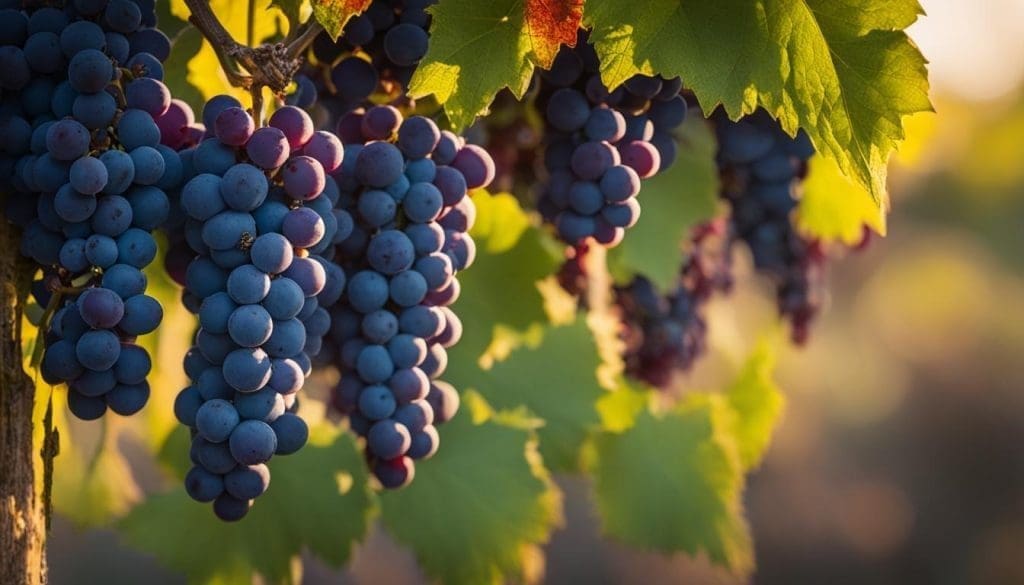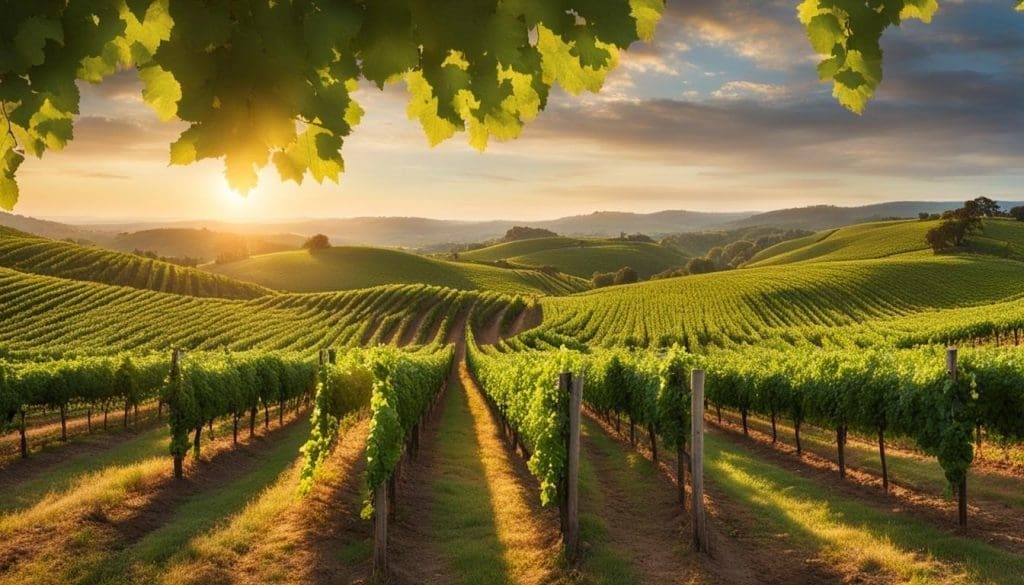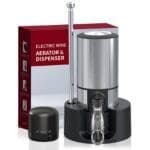This post may contain affiliate links. Please read my disclosure policy.
Oh là là! Welcome to the mesmerising realm of Cabernet Sauvignon, a premier red wine varietal that has captured the hearts and palates of wine enthusiasts around the globe. With its unapologetically bold flavours and impeccable pedigree, the best Cabernet Sauvignon wines have earned their rightful place among the crème de la crème of wine offerings. In this article, we’ll take you on a guided tour through the captivating journey of Cabernet Sauvignon, leaving no vintage unturned. So grab a glass, swirl your worries away, and let’s set off on our vinicultural adventure!
Key Takeaways
- Cabernet Sauvignon is a much-loved red wine varietal known for its rich and bold flavours.
- Originating from the Bordeaux region of France, this varietal has become a global sensation.
- Our journey will explore the history, character, and winemaking process of Cabernet Sauvignon.
- Distinct regions around the world produce a diverse array of Cabernet Sauvignon wines.
- Wine ratings and reviews can help wine enthusiasts navigate the world of Cabernet Sauvignon.
- Engaging with the Cabernet Sauvignon wine experience can unlock new flavours, treasures, and adventures.
A Sip of History: The Origins of Cabernet Sauvignon
As one of the most renowned and highly prized red wines, understanding Cabernet Sauvignon’s intricate past is essential to appreciating its present glory. Our journey into the history of this beloved red varietal will take us through its humble beginnings as a Bordeaux grape and beyond, charting its spread across global wine regions, where it would become the powerhouse of the wine production industry.
The Bordeaux Beginnings
Cabernet Sauvignon’s storied history can be traced back to the 17th century in the Bordeaux region of France. The grape was the result of an accidental yet fortunate cross between the Cabernet Franc and Sauvignon Blanc grapes, from which its unique name was derived. Over the centuries, it earned its prestigious title as a Bordeaux grape and became an instrumental component in the creation of the most sought-after wines in history, including the world-renowned Bordeaux blends.
“Wine is the most healthful and most hygienic of beverages.” – Louis Pasteur
The Bordeaux region’s diverse climate and soil coalesce to create a uniquely nurturing terroir, producing grapes with distinctive profiles that define the region’s esteemed wines. From tannic and bold to cultivate and refined, the region’s varying class of wines showcase the grape’s unmatched potential.
The Spread Across the Globe
As Cabernet Sauvignon’s global dissemination took root, it ventured beyond the borders of France, and a multitude of factors contributed to the varietal’s diversification. Different global wine regions, each with their unique climates and soils, embraced Cabernet Sauvignon and established a distinct expression of the grape based on the specific terroir and varied wine-making techniques. Over time, these individual styles became synonymous with each respective region, further cementing its status as a globally desired varietal.
| Region | Country | Year Introduced | Characteristic Style |
|---|---|---|---|
| Bordeaux | France | 17th Century | Structured and tannic |
| Napa Valley | United States | 1800s | Full-bodied and fruity |
| Maipo Valley | Chile | 19th Century | Rich and elegant |
| Barossa Valley | Australia | 1800s | Bold and jammy |
From its origins in Bordeaux to its adaptation in Napa Valley and beyond, the dynamic nature of Cabernet Sauvignon allowed the grape to expand its horizon and adapt to various climates and terroirs. These factors, coupled with innovative wine-making techniques, created an astounding diversity that propelled the Cabernet Sauvignon varietal to the apex of the wine world.
Characteristics of the Cabernet Sauvignon Grape

As one of the most iconic red wine varieties, the Cabernet Sauvignon has distinct characteristics that render it a favourite among wine enthusiasts. Esteemed for its rich flavour profile, structured body, and unparalleled versatility in food pairings, it’s no wonder that the Cabernet Sauvignon grape continues to hold the palates of wine lovers captive. Let’s dissect the elements that make this varietal truly exceptional.
“Cabernet Sauvignon – the King of Grapes, not just by virtue of the volume it produces, but for the fact that it’s most important in quality.” – Jancis Robinson, British wine critic
Flavour Profile and Tasting Notes
From the first sip to the last lingering note, a well-crafted Cabernet Sauvignon wine transports you on a journey of sensorial delight. At its core, the wine boasts a luscious medley of dark fruit flavours like blackcurrant, blackberry, and plum complemented by savoury, earthy undertones. These innate flavours harmonise with overt tertiary notes developed during the aging process, such as leather, tobacco, and cedar.
As one explores the depths of Cabernet Sauvignon, additional layers of complexity unfold, presenting nuances of green bell pepper, eucalyptus, and mint. Supported by its firm tannin structure and balanced acidity, this powerful grape delivers a full-bodied, lasting experience with every pour.
| Primary Flavours | Secondary Flavours | Tertiary Flavours |
|---|---|---|
| Blackcurrant | Green Bell Pepper | Leather |
| Blackberry | Eucalyptus | Tobacco |
| Plum | Mint | Cedar |
Food Pairings
The Cabernet Sauvignon’s robust character and concentrated flavours make it a versatile companion to a wide array of dishes. Its powerful tannins make it an ideal match for protein-rich foods, as they soften the wine’s astringency.
- Red Meats: Grilled steak, lamb chops, and prime rib
- Game: Venison, kangaroo, and wild boar
- Poultry: Roasted duck and turkey
- Rich Vegetables: Sauteéd mushrooms and eggplant
- Cheeses: Aged cheddar, gouda, and blue cheese
It’s important to note that regional variations in Cabernet Sauvignon wines will influence their unique gastronomic pairings. For example, a Cabernet from Western Australia’s Margaret River will exhibit more pronounced eucalyptus notes, pairing exceptionally well with herb-crusted lamb.
Unlock the world of Cabernet Sauvignon grapes by embarking on a delectable wine tasting journey. From the glass to the plate, this venerable grape variety has plenty to offer both novice and seasoned oenophiles, solidifying its status as a captivating blend of power, grace, and elegance.
The Art of Wine Making with Cabernet Sauvignon
Creating the perfect bottle of Cabernet Sauvignon relies on a delicate interplay of wine production techniques, which include expert harvesting methods and the art of fermentation and aging. Understanding these intricate processes showcases the craftsmanship that goes into producing this exquisite red wine.
Harvesting and Fermentation
Like all great wines, the journey of Cabernet Sauvignon wine-making begins in the vineyard. Harvesting techniques have a significant impact on the final product. The timing of the harvest is crucial, as it determines the wine’s flavour profile, acidity, and overall balance. Winemakers look for cues such as grape colour, seed ripeness, and texture for deciding the ideal time to harvest the grapes.
The fermentation process that follows is no less fascinating. The winemaker must decide on factors like fermentation temperature and yeast selection, which influence the wine’s taste and aroma. During fermentation, sugar in the grape juice is converted into alcohol. Slower fermentations at lower temperatures help maintain the fruit’s more delicate flavours, while warmer fermentation encourages the development of bolder, more robust notes.
“Stainless steel and oak barrels are commonly used to ferment red wines, but fermenting Cabernet Sauvignon in oak can impart a more profound, integrated oak influence on the final product.”
Oak Aging and Its Influence
Oak aging is an essential aspect of the Cabernet Sauvignon wine-making process. It imparts additional complexity and elegance to the already distinguished flavour profile. Aging in oak barrels allows the wine to breathe, which softens tannins and develops more nuanced flavour characteristics.
Understanding the various oak aging options is crucial since different types of oak can impact the aged Cabernet Sauvignon’s taste. Winemakers often choose between two alternatives: American oak and French oak. They differ in their density, grain pattern, and overall influence on the wine.
| Type of Oak | Flavour Impact | Common Aging Period |
|---|---|---|
| American Oak | Sweet, spicy, and strong vanilla notes | 6-18 months |
| French Oak | Subtle, refined, and elegant with subtle spice and vanilla | 12-24 months |
Aside from the type of oak, factors such as the age of the barrel, the varying levels of toasting on the barrel’s interior surface, and the duration of oak aging contribute to the wine’s evolving nature. Each decision can greatly influence the final product, making wine aging a true art in a bottle.
- French Oak: Barrels made from French oak impart subtler flavour profiles, with a luxurious silkiness and balanced spice notes that complement Cabernet Sauvignon’s robust character.
- American Oak: Barrels crafted from American oak contribute strong, sweet, and spicy vanilla notes that give depth and richness to the final wine.
In conclusion, the fascinating journey of Cabernet Sauvignon wine-making consists of steps such as harvesting techniques, fermentation, and oak aging. Each stage of the process adds another layer of complexity to the finished product, making it a remarkable testament to the skill and dedication of the winemakers involved.
World’s Prestigious Cabernet Sauvignon Regions
For wine lovers seeking to explore the diverse flavours and terroirs of Cabernet Sauvignon, several renowned vineyards around the globe encapsulate the essence of this exquisite varietal. From Bordeaux’s iconic estates to Napa Valley’s innovative wineries and beyond, these prestigious wine regions showcase the versatility and charm unique to Cabernet Sauvignon.
“Wine is a passport to the world.” – Thom Elkjer
Let’s embark on a journey through some of the most celebrated Cabernet Sauvignon vineyards and discover the treasures within these global wine territories.
- Bordeaux, France
- Napa Valley, California, USA
- Coonawarra, South Australia
- Maipo Valley, Chile
- Stellenbosch, South Africa

Bordeaux, France: The birthplace of Cabernet Sauvignon, Bordeaux’s terroir offers the perfect harmony of climate, soil, and tradition to produce world-class wines. Cabernet Sauvignon thrives in the legendary vineyards of the Left Bank, including iconic estates such as Château Lafite Rothschild, Château Latour, and Château Mouton Rothschild.
Napa Valley, California, USA: In the heart of California’s thriving wine region lies the Napa Valley, renowned for its remarkable Cabernet Sauvignon wines. Excellence and innovation in winemaking are evident in estates like Opus One, Silver Oak, and Caymus Vineyards, which craft bold and opulent expressions of the varietal.
Coonawarra, South Australia: Known for its terra rossa soil and cool climate, Coonawarra has cultivated a reputation for producing exceptional Cabernet Sauvignon wines. Distinctive in style, Australian Cabernet is brought to life through wineries like Wynns Coonawarra Estate and Bowen Estate, boasting exceptional structure and longevity.
Maipo Valley, Chile: Lying at the foothills of the Andes Mountains, Maipo Valley has emerged as a Cabernet Sauvignon powerhouse in recent years. Chile’s flagship grape is masterfully crafted by wineries such as Viña Almaviva and Viña Santa Rita, which create outstanding wines with a unique South American flair.
Stellenbosch, South Africa: With a winegrowing history dating back to the 17th century, Stellenbosch has earned its place among the top Cabernet Sauvignon producing regions in the world. Celebrated wineries like Rust en Vrede and Vergelegen showcase the immense potential of the South African terroir in crafting outstanding Cabernet Sauvignon wines.
| Region | Old World / New World | Notable Wineries |
|---|---|---|
| Bordeaux, France | Old World | Château Lafite Rothschild, Château Latour, Château Mouton Rothschild |
| Napa Valley, California, USA | New World | Opus One, Silver Oak, Caymus Vineyards |
| Coonawarra, South Australia | New World | Wynns Coonawarra Estate, Bowen Estate |
| Maipo Valley, Chile | New World | Viña Almaviva, Viña Santa Rita |
| Stellenbosch, South Africa | New World | Rust en Vrede, Vergelegen |
As we indulge in the varied flavours and nuances of Cabernet Sauvignon wines hailing from these esteemed regions, their global appeal and timeless sophistication are undeniably evident. So, raise a glass to the captivating allure of Cabernet Sauvignon and the enchanting vineyards that perpetuate its legacy.
Decoding the Labels: Understanding Cabernet Sauvignon Wine Ratings and Reviews
In the world of wine, Cabernet Sauvignon commands respect and attention. Both experienced oenophiles and newcomers can find the rich variety of cabernet sauvignon wine ratings, reviews, and scorecards to be a bit overwhelming at first. Fear not — this section will guide you through how to interpret wine critic insights and what these ratings mean for consumers, ensuring that you can make informed decisions and enhance your wine education.
Navigating Wine Critic Reviews
Wine critics are experts who offer their opinions on wines through tasting notes and reviews. From renowned critics like Jancis Robinson and Robert M. Parker Jr. to experienced sommeliers sharing their thoughts online, their insights can be invaluable for buyers seeking quality Cabernet Sauvignon wines.
- Look for consistency: Seek recommendations from critics with a consistent track record of identifying quality wines within your preferred wine styles.
- Understand the critic’s preferences: Some wine critics have distinct preferences that may not align with your own tastes. Focus on insights from those whose opinions resonate with your own.
- Join a wine club: Cabernet Sauvignon wine clubs often curate selections based on expert reviews, allowing you to discover highly rated wines with ease.
Scorecards and What They Mean for Consumers
One of the most widely used tools for evaluating wines is the 100-point wine scorecard system. Critics assign numerical ratings to wines, often accompanied by tasting notes to give a more detailed description of a wine’s attributes.
“92 points – A rich and luxurious Cabernet Sauvignon with bold black fruit flavours, smooth tannins, and hints of dark chocolate and oak on the finish. A truly exceptional wine, perfect to unwind with after a long day.” – Jane Smith, Wine Reviewer
So, what do these scores really mean? Wine scores within the 100-point system can generally be broken down into these categories:
| Score Range | Description |
|---|---|
| 95–100 | Outstanding or classic, top-tier wines |
| 90–94 | Excellent, highly recommended wines |
| 85–89 | Very good wines with above-average quality |
| 80–84 | Good, everyday wines with no significant flaws |
| 75–79 | Mediocre wines with minor flaws |
| 50–74 | Not recommended |
Bear in mind that scores are subjective, and a critic’s evaluation may not perfectly match your wine preferences. However, these scores can serve as a helpful starting point to discover quality Cabernet Sauvignon wines and further your consumer wine education.
In Conclusion: Savour the Cabernet Sauvignon Experience
As we draw to a close, it’s evident that Cabernet Sauvignon is more than just a renowned wine varietal – it’s an entire world of bold flavours waiting to be explored. From the vine to the glass, a single sip encapsulates centuries of history and winemaking expertise. Sharing a glass of Cabernet Sauvignon with friends provides an opportunity not just to indulge in its rich taste, but to delve into and appreciate its storied past.
There’s no better way to broaden your cabernet sauvignon wine experience than to immerse yourself in the culture that has blossomed around this illustrious grape. Whether you choose to partake in wine tours, attend festivals or join wine clubs, your journey with this varietal is limited only by your enthusiasm.
And, as we reach our wine tasting conclusions, don’t hold back from extending the gift of Cabernet Sauvignon to others. Share the love by presenting them with a well-chosen bottle or inviting them along to a tasting event. After all, a great Cabernet Sauvignon is best enjoyed in good company. Raise a glass to the many adventures that await you, and toast to the timeless elegance of the Cabernet Sauvignon.
FAQ
What makes Cabernet Sauvignon unique among red wines?
Cabernet Sauvignon is known for its bold flavours, rich tannins, and impressive aging potential. As a premier wine varietal, it is loved by enthusiasts around the globe, and is celebrated for its diverse flavour profile depending on the region it’s grown in.
Where did Cabernet Sauvignon originate?
The Cabernet Sauvignon grape has its roots in the Bordeaux region of France, where it initially gained popularity as a cornerstone of the wine production industry. This “Bordeaux grape” has since spread to other global wine regions, showcasing unique characteristics in different climates and soils.
What are some Cabernet Sauvignon food pairings?
Cabernet Sauvignon is a versatile wine for pairing with food due to its rich flavour profile and structure. Classic pairings include red meats, rich sauces, aged cheeses, and hearty vegetables. The specific flavours of individual Cabernet Sauvignons may inspire other creative pairings.
How does oak aging affect Cabernet Sauvignon?
Oak aging plays a significant role in crafting the flavour profile and texture of Cabernet Sauvignon wines. Different types of oak can influence the wine’s taste, imparting various levels of toasty, spicy, or vanilla notes, and affecting the overall smoothness and complexity of the final product.
What are some prestigious Cabernet Sauvignon regions around the world?
While Bordeaux is the birthplace of Cabernet Sauvignon, other prestigious regions have emerged across the globe, including Napa Valley in California, Coonawarra in Australia, Bolgheri in Italy, and Maipo Valley in Chile. These regions showcase diverse expressions of the Cabernet Sauvignon grape.
How can I better understand Cabernet Sauvignon wine ratings and reviews?
Wine critic reviews and rating systems, such as the 100-point scorecard, can provide valuable guidance for wine enthusiasts navigating the world of Cabernet Sauvignon. Understanding how to interpret these reviews and scores can inform buyer’s choices, deepen wine education, and enhance engagement with wine clubs focused on this varietal.
What are some ways to further explore Cabernet Sauvignon wines?
To delve deeper into the world of Cabernet Sauvignon, consider participating in wine tours, attending wine festivals or tastings, joining a Cabernet Sauvignon-focused wine club, or gifting a fine bottle to fellow wine lovers. These experiences offer an opportunity to appreciate the global appeal and timeless sophistication of this iconic varietal.
Sip smarter, subscribe now!
Subscribe for gourmet tips, event updates, travel ideas, and a free e-book on Food Pairings. Start your journey to culinary and travel excellence!















